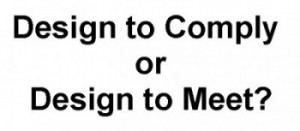
We attempt to ensure products comply with regulatory requirements, both safety and EMC. With regard to EMC, compliance engineers always seek an elusive 3 dB margin, yet if we are a few dBs over the specification limit does this mean the product is a hazard to other electrical products and the environment that it is used within. Should it be prevented from being placed on the market regardless of what measurement uncertainty values are? Regulatory authorities, or those having jurisdiction, could take time at great expense to prosecute companies for non-compliance. Therefore, should design engineers focus on meeting a marketing specification “Designing to Meet“, or ensure electromagnetic compatibility and product safety by “Designing to Comply“? This means the product will function and survive in an environment that may be outside of anticipated use and survive for its’ intended life cycle.
With technological advances, our focus as EMC engineers must be to ensure products are designed to survive high levels of immunity protection and to maintain reliability and quality of performance. What may happen when everyone with a hand phone containing multiple wireless features (e.g., GPS, WiFi, Bluetooth, etc.) operate at the same time in one location? Is undesired EMI from many intentional radiators operating on nearly the same frequency now become a concern according to a [generic] regulatory standard and test specification? However, if a strong RF signal from a high-power transmitter occurs nearby, all other devices could become non-functional or we incur loss of data. With this scenario, we should not worry about “radiated” EMI from many devices sharing a large spectral bandwidth of frequencies at the same time, but “preventing EMI energy from causing harm to critical systems”. For example, medical products must be robust against high intensity RF fields in a hospital environment. Transportation systems must be 100% reliable when traveling anywhere in the world. In the future, EMC engineers must ensure products operate in an RF rich broadband wireless world but not be disrupted from RF energy in the environment. Therefore, EMC engineers must ensure compliance and not just focus on achieving that elusive 3 dB margin, which is essentially designing to meet.





Leave a Reply